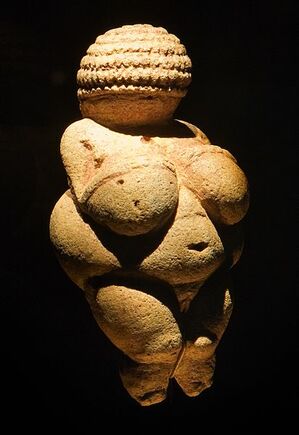|
The Breadcrumbs widget will appear here on the published site.
Fatness RevisitedBy Ghia Vitale Most people don’t learn about fat history because it’s not taught in most schools. However, the history of fatness is real and worth knowing. Here are some important moments and plus size icons that deserve recognition. The history of fatness extends around the world. Very few people can see past the stigma of fatness today to truly appreciate this history. In reality, there’s a whole history to fatness and the varying levels of acceptance from different societies. The modern world didn’t “invent” fatness. Fat people have always been around and will continue to exist in the future. Here are some significant moments that made fat history: The Venus of Willendorf is a statuette made around 30,000 BCE. The statuette depicts a woman with full hips, large breasts, pronounced tummy, and thick thighs. Researchers think “Venus figurines” like the Venus of Willendorf came from early people’s idea of a fertile woman or a mother goddess. This Venus figurine is proof that ancient people accepted the idea of fat women being attractive. Peter Paul Rubens is a Flemish painter who’s famous for painting fat women. He was born on June 28, 1577. In fact, the term “Rubenesque” (meaning curvaceous and plump) comes from his name. He often painted Venus as fat and full-figured. In Tahiti, 19th century researchers discovered women and men alike participating in a ritual called ha’apori or “fattening.” The people who engaged in this fattening ritual were usually from the upper-class part of society. During this ritual, they would stay in a designated home while being cared for by relatives and friends. The person would then emerge larger, more full, and therefore “more attractive.” This ritual is no longer practiced in Tahiti, but the people there still consider fat people to be attractive. In 1942, The Metropolitan Life Insurance Company made a set of tables that became the most popular medical standards for weight in the United States. To arrive at their numbers, the life insurance company averaged the ages, weights, and mortality rates of over 5 million policies across the United States and Canada. This was the first time doctors had a reference for what they think patients “should” weigh. Meanwhile, BMI is not an accurate measure of health. Duane B. "Dick" Bryers illustrated the plus-size pinup named “Hilda” in the 1950’s. Other pinup girls at the time like Marilyn Monroe were certainly curvy, but they weren’t outright plus size like Hilda. She is a bubbly redhead who Bryers depicted in both innocent and sometimes risque situations. She isn’t afraid to show some skin, either. Hilda remained in print until somewhere in the 1980’s. In 1967, there was a “fat-in” that took place at New York’s Central Park. “Fat-in” is a play on the 60’s term “love-in,” which was used to describe a peaceful protest that often focused on meditation, sex, music, love, and using psychedelic drugs. At the fat-in, over 500 people gathered to protest anti-fat bias. They ate, carried signs/pictures of Sophia Loren (an actress whose famous for her curvy figure), and burned diet books. In 1967, Lew Louderback wrote an article called "More People Should be FAT" about discrimination against his wife. This article led to Lew Louderback meeting William Fabrey. In 1969, both of them formed the first organization to advocate on fat people’s behalf. At first, the organization was called “National Association to Aid Fat Americans” and now, it’s called NAAFA (“National Association to Advance Fat Acceptance”). The Fat Underground formed as a radical feminist chapter of NAAFA in 1972. The Fat Underground protested the otherism of fat people by the scientific community. This group came up with the saying, "A diet is a cure that doesn't work, for a disease that doesn't exist." In 1979, Carole Shaw launched BBW Magazine, a magazine for plus-size women. “BBW” stands for “Big Beautiful Woman” and is still used as a term of endearment for plus-size women. The magazine went out of print in the late 1990’s. Many plus size women identify with the term “BBW” because it acknowledges that fat women can also be beautiful. However, others find the term to be fetishizing. (Side note: When I was younger, I used to identify as a BBW. Calling myself a BBW was one of my first forays into appreciating my own beauty. However, I also understand how it can be fetishizing.) There are certain plus size icons that emerged in recent years. Mo’Nique is a plus size actress and comedian who has starred in a diverse array of different roles. This includes her starring role in the movie Phat Girlz that was released in 2006. In the movie, Jazmin (Mo’Nique’s main character) is a designer who finds love with a man from Africa. The movie emphasizes how different cultures have different beauty standards. Another plus size icon is Queen Latifah. She is a singer and plus size woman. Her music career began in 1988 and hasn’t stopped yet. Not only is she admired for her beauty, but she is considered a sex symbol and an empowering figure. One example of this is her song “U. N. I. T. Y.” which is about respecting women. Beth Ditto is a plus size icon who’s a singer and songwriter. She’s known for being in Gossip, an American indie rock band. Beth Ditto is a lesbian who supports feminism and body positivity. In 2007, Beth Ditto was even nominated as Sexiest Woman Of The Year for the NME Awards. Her prominence helps fat femmes understand that we, too, are beautiful. Now, more fat women are taking the spotlight in the media. For instance, Aidy Bryant plays the plus size protagonist in Shrill, a web television series on Hulu. Shrill’s release is important because it’s a series that doesn’t feature a fat person “redeeming themselves” through weight loss. The series is also body positive and fat positive. Lizzo is probably the plus size icon of 2019. She’s an American rapper, singer, songwriter, flautist, and actor. She’s also a fat black woman in the mainstream spotlight. She’s been releasing albums since 2013, including Big Grrrl Small World in 2015. Fat history is still in the making. It’s still acceptable to discriminate against people who are fat. However, beauty standards are changing and fatness is becoming larger than life in the public eye. I look forward to seeing a future in which fat people thrive. If you want to learn more about fat history, follow historicalfatpeople on Instagram. This account showcases many significant fat individuals in history that you should know about.
0 Comments
CommentsYour comment will be posted after it is approved.
Leave a Reply. |
AuthorWrite something about yourself. No need to be fancy, just an overview. Archives
July 2024
Categories
All
|



 RSS Feed
RSS Feed






